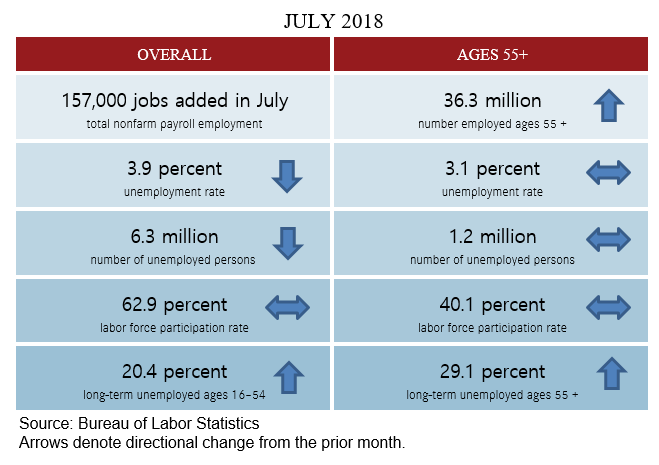AARP Eye Center
Fewer Jobs Added in July but Labor Force Participation Rates Remain Stable
By Jennifer Schramm, August 6, 2018 03:46 PM

Employment Overview
Total nonfarm payroll grew by 157,000 jobs, down from 248,000 jobs (revised up from 213,000) in June, according to the Bureau of Labor Statistics’ (BLS) July Employment Situation Summary. The unemployment rate edged down to 3.9 percent. Jobs were added in professional and business services, manufacturing, and health care. The labor force participation rate held steady at 62.9 percent and the number of unemployed decreased from 6.6 million in June to 6.3 million in July.
The number of people ages 55+ who were employed increased slightly from 36.2 million in June to 36.3 million in July. The number of unemployed people ages 55 and older remained unchanged at 1.2 million. The labor force participation rate for those ages 55+ was also unchanged for the third consecutive month at 40.1 percent, and the unemployment rate for the 55+ remained at 3.1 percent.
Spotlight: Job openings and quits are high, yet wages stay flat
Recent job openings and labor turnover data paint a picture of a strong U.S. economy, yet wages continue to be stagnant. In April, there were 6.8 million U.S. job openings, the highest level since the series began in December 2000. Though the number of U.S. job openings fell to 6.6 million in May, the “quits rate,” i.e., the rate of workers in the private sector quitting their jobs, rose to 2.7 percent in May from 2.5 percent in April, reaching the highest level since 2001.
With job openings and quits rate so high, economists would normally expect to see wages rising as employers compete for talent. Instead, BLS data show that real average hourly earnings were unchanged from June 2017 to June 2018, and production and nonsupervisory employees’ real average hourly earnings actually decreased by 0.2 percent. These wage numbers look even worse when inflation is taken into account.
Stagnant wages are not only a problem in the U.S. The OECD Employment Outlook 2018, which reviews employment trends across the world’s wealthiest nations, reports that in 2007 prior to the Great Recession, real wage growth was 2.2 percent, but by 2017 it had declined to 1.2 percent despite unemployment rates being roughly at the same levels. Although unemployment rates in most OECD countries are either below or very close to their pre-recession levels, poverty has actually grown among the working age population.
In both the U.S. and across the OECD area, wage stagnation has had disparate affects across the workforce. The incomes of the top 1 percent of earners have increased much faster than those of median full-time workers, but wage stagnation has affected low-paid workers most of all. So as economists continue to debate why a stronger economy is not leading to rising earnings for workers, the lack of wage growth will make saving for retirement more challenging, especially for those earning the lowest wages.
Find more details on the latest employment data in the July Employment Data Digest, PPI’s monthly review of job trends for those ages 55 and over.
























































